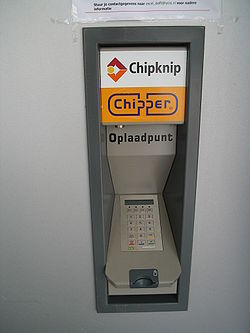  "Oplaadpunt" (English: Upload point) for the Chipknip and Chipper where money could be deposited onto the card or withdrawn back to the bank account. Chipper was initially an incompatible alternative, but became a differently branded Chipknip after 2001. | |
| Location | The Netherlands |
|---|---|
| Launched | 26 October 1995 |
| Discontinued | 1 January 2015 |
| Operator | |
| Currency | Guilder, replaced by the Euro in 2001 (500 of both currencies maximum load) |
| Website | chipknip.nl at the Wayback Machine (archived 16 February 2012) |
Chipknip (a portmanteau of chip card and knip, Dutch for purse) was a stored-value payment card system used in the Netherlands. Based on the Belgian Proton system, it was started by Interpay on 26 October 1995, as a pilot project in the city of Arnhem and a year later rolled out countrywide. Chipknip was taken over by Currence due to a restructuring on 17 May 2005, who managed it with their licensees until its discontinuation on 1 January 2015. The Chipknip was primarily used for small retail transactions, as the card could contain a maximum value of 500 euros. The money needed to be transferred from a card holders main bank account using a loading station which were generally located next to ATMs.
In 1996, The Postbank left the Chipknip project and started the Chipper project with other organisations such as PTT Telecom to compete with the Chipknip until 2001, when it merged into the Chipknip system.
Its peak was in 2010, when a total of 178 million transactions were made. Since its discontinuation, contactless payments without pin code for small transactions using Maestro or V Pay have largely become the norm.